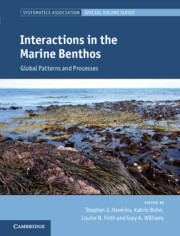Book contents
- Interactions in the Marine Benthos
- The Systematics Association Special Volume Series
- Interactions in the Marine Benthos
- Copyright page
- Contents
- Preface
- Contributors
- Chapter 1 Introduction
- Chapter 2 The Intertidal Zone of the North-East Atlantic Region
- Chapter 3 The Ecology of Rocky Subtidal Habitats of the North-East Atlantic
- Chapter 4 Rocky Intertidal Shores of the North-West Atlantic Ocean
- Chapter 5 Subtidal Rocky Shores of the North-West Atlantic Ocean
- Chapter 6 Shallow Water Muddy Sands of the North-West Atlantic Ocean
- Chapter 7 Biodiversity and Interactions on the Intertidal Rocky Shores of Argentina (South-West Atlantic)
- Chapter 8 Species Interactions and Regime Shifts in Intertidal and Subtidal Rocky Reefs of the Mediterranean Sea
- Chapter 9 The Restructuring of Levant Reefs by Aliens, Ocean Warming and Overfishing
- Chapter 10 North-East Pacific
- Chapter 11 The North-East Pacific
- Chapter 12 Consumer–Resource Interactions on an Environmental Mosaic
- Chapter 13 Where Three Oceans Meet
- Chapter 14 Rocky Shores of Mainland China, Taiwan and Hong Kong
- Chapter 15 Biogeographic Comparisons of Pattern and Process on Intertidal Rocky Reefs of New Zealand and South-Eastern Australia
- Chapter 16 The Past and Future Ecologies of Australasian Kelp Forests
- Chapter 17 Kropotkin’s Garden
- Chapter 18 Biofilms in Intertidal Habitats
- Chapter 19 Interactions in the Deep Sea
- Chapter 20 Overview and Synthesis
- Index
- Systematics Association Special Volumes
- References
Chapter 9 - The Restructuring of Levant Reefs by Aliens, Ocean Warming and Overfishing
Implications for Species Interactions and Ecosystem Functions
Published online by Cambridge University Press: 07 September 2019
- Interactions in the Marine Benthos
- The Systematics Association Special Volume Series
- Interactions in the Marine Benthos
- Copyright page
- Contents
- Preface
- Contributors
- Chapter 1 Introduction
- Chapter 2 The Intertidal Zone of the North-East Atlantic Region
- Chapter 3 The Ecology of Rocky Subtidal Habitats of the North-East Atlantic
- Chapter 4 Rocky Intertidal Shores of the North-West Atlantic Ocean
- Chapter 5 Subtidal Rocky Shores of the North-West Atlantic Ocean
- Chapter 6 Shallow Water Muddy Sands of the North-West Atlantic Ocean
- Chapter 7 Biodiversity and Interactions on the Intertidal Rocky Shores of Argentina (South-West Atlantic)
- Chapter 8 Species Interactions and Regime Shifts in Intertidal and Subtidal Rocky Reefs of the Mediterranean Sea
- Chapter 9 The Restructuring of Levant Reefs by Aliens, Ocean Warming and Overfishing
- Chapter 10 North-East Pacific
- Chapter 11 The North-East Pacific
- Chapter 12 Consumer–Resource Interactions on an Environmental Mosaic
- Chapter 13 Where Three Oceans Meet
- Chapter 14 Rocky Shores of Mainland China, Taiwan and Hong Kong
- Chapter 15 Biogeographic Comparisons of Pattern and Process on Intertidal Rocky Reefs of New Zealand and South-Eastern Australia
- Chapter 16 The Past and Future Ecologies of Australasian Kelp Forests
- Chapter 17 Kropotkin’s Garden
- Chapter 18 Biofilms in Intertidal Habitats
- Chapter 19 Interactions in the Deep Sea
- Chapter 20 Overview and Synthesis
- Index
- Systematics Association Special Volumes
- References
Summary
The Levantine Basin at the south-eastern corner of the Mediterranean represents the trailing edge of the distribution of native Atlanto-Mediterranean species, where they are exposed to the most extreme temperature and salinity conditions. The region is also fast warming and exposed to a flood of alien species, mostly thermophilic ones from the Indo-Pacific. The Levant coast also hosts a unique, fragile and understudied rocky intertidal ecosystem – vermetid reefs. Anecdotal historical data and observations, and recent extensive intertidal and shallow subtidal community surveys on the Israeli coast (including a marine reserve) indicate that Levant reefs are (1) overfished; (2) highly invaded by thermophilic alien species, some (rabbitfish) highly destructive; (3) dominated by turf barrens (canopy-forming brown algae are rare, probably overgrazed by rabbitfish) and increasing patches of alien algae and (4) suffering the loss of many native species (e.g., urchins subtidally and the main reef-building vermetid gastropod, Dendropoma petraeum, intertidally). Laboratory work has shown that many native species that are still abundant are likely to disappear under increasing warming, while aliens are much more resistant. Mesocosm experiments demonstrated that, under both warming and acidification, the community structure will further shift, and whole community functions will transform from autotrophic to heterotrophic.
Keywords
- Type
- Chapter
- Information
- Interactions in the Marine BenthosGlobal Patterns and Processes, pp. 214 - 236Publisher: Cambridge University PressPrint publication year: 2019
References
- 2
- Cited by

